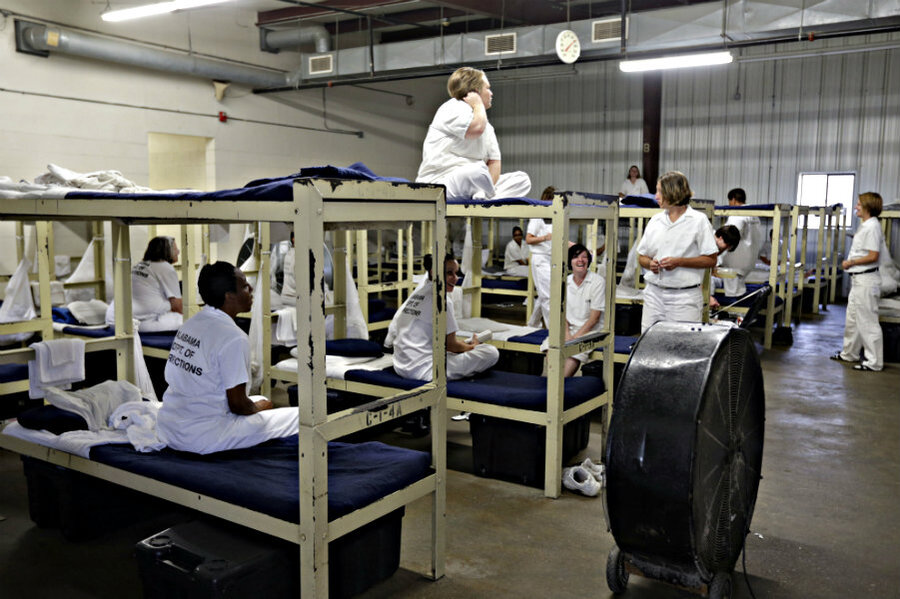Could these large-scale prison protests lead to better conditions for inmates?
Loading...
In the midst of nationwide strikes this fall to protest poor prison conditions, one incarcerated Alabama strike leader named Robert Earl Council, or “Kinetic Justice,” is officially hunger striking, according to the Alabama Department of Corrections.
Prisoners across the nation stepped up to speak out about poor prison conditions in September, sparking objections against prison care, inmate pay, and crowding – issues that they say are too often ignored by the general public.
As the second month of the strikes draws to a close, involving at least 20,000 inmates in 23 states, have the prisoners' actions been able to effect change?
“This is breaking through into public consciousness in a way that previous actions have not,” says American Civil Liberties Union National Prison Project director David Fathi in a phone interview with The Christian Science Monitor.
While prison strikes and uprisings have not been unheard of throughout the past several decades, the collaborative decision of inmates in different states to refuse to participate in mandatory prison labor last September was an unusual display of coordination and strength.
As presidential candidates discussed incarceration rates and crowded prison facilities on national news, prisoners protested what they called “cruel and inhuman conditions” in the country’s jails this fall.
Inmates are forced to work whole days for less than the cost of a Starbucks coffee, they said. Conditions in prisons like Alabama’s Holman Correctional Facility where Mr. Council was held before he began his strike are crowded and dismal, they said.
Mr. Fathi tells the Monitor that in some prisons, overcrowding is so bad that prisoners are forced to sleep on the floor. In Alabama’s prison system, for example, prisons are at 200 percent of their maximum capacity.
In early October, the federal Department of Justice announced that it would be conducting a statewide investigation into Alabama’s prison system.
Prisons profit off of prisoners, says logy Elaine Leeder, professor of sociology at Sonoma State University.
“It is slave labor, making two dollars a day,” Dr. Leeder tells the Monitor. “In terms of the kind of work that they do, in terms of the fact that prisons profit off the sale of items made in prison.”
“It’s the prison industrial complex.”
In Alabama, Council has since been moved to a different prison and is currently being held in solitary confinement. Pastor Kenneth Glasgow, a spokesperson for the Free Alabama Movement, says that Council is also being held in a dry cell without any plumbing, though prison officials say that this is untrue.
When prisoners coordinated to create the most widespread inmate protest event of the last several decades in September, the Monitor’s Ben Rosen reported that the nation was beginning to discuss incarceration in a way that it never had before.
The incarcerated protesters have demanded they receive more workers' rights to end conditions they characterize as “slave labor.” And, unlike in Attica in 1971, they are engaging in an ongoing, public conversation.
The work stoppages came as bipartisan consensus has begun to coalesce around prison reforms, with President Obama and his administration announcing last month that private prisons will be phased out this year. The protests fit into a larger narrative about how to transition the country’s criminal justice system out of the so-called mass incarceration era, marked by three-strike policies and mandatory minimum sentences popularized in the 1990s.
Still, despite optimism in some quarters, Leeder says that not much has changed, telling the Monitor that, “In the long run, we’ve come a long way, but there’s a heck of a long way to go.”
“Unless a concerted group of people keep it front and center on the agenda, nothing will really change. I’m hoping that because of this publicity, it will have an impact.”
Nevertheless, Fathi tells the Monitor that as individuals like Council take strong stances, their efforts are signals to the movement that things can change.
“The actions of one person can be influential and effective, but as in most cases, a group of people are stronger when they stand together,” Fathi says. “Individually, his protest is powerful, but the fact that it’s being done in conjunction with tens of thousands of other prisoners makes it more powerful.”






